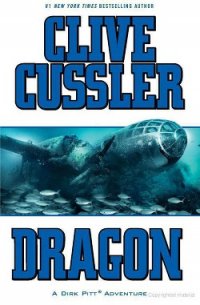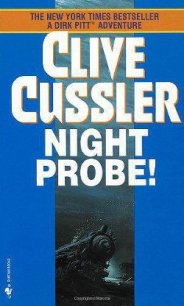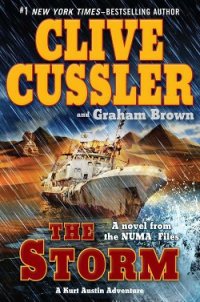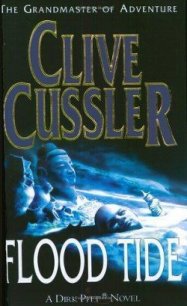Black Wind - Cussler Clive (читать книги онлайн без сокращений TXT) 📗
A seal cap on one of the drums had not been tightened all the way, allowing a thin wisp of vapor to escape. The constant jarring from the pounding boat had generated more vapor pressure inside the drum, which expanded further by the heat of the nearby fire. When the flames finally drew near enough to ignite the vapor, the fuel drum exploded like a powder keg. In quick succession, the other three fuel drums ignited with devastating effect.
As the blimp peeled away from the boat, Pitt and the others watched in awe as the first fuel drum exploded right into Tongju. A chunk of flying shrapnel from the drum burst through his body, tearing an oblong hole the size of a Softball through his chest. A stunned look crossed the assassin's face as he sunk to his knees. In the last seconds of life, he peered skyward toward the blimp and scowled defiantly before he was swallowed up in an inferno of flames.
The subsequent explosions leveled the entire superstructure of the boat in a maelstrom of flying timbers and debris. A huge fireball rolled into the sky as the stern of the boat rose into the air briefly, its still-driving propellers churning at the sky. The explosion blasted a gaping hole through the hull, which quickly sucked the boat under the waves in a boil of froth and smoke, taking the bodies of Tongju, Kim, and the third commando to the seafloor.
Giordino had sharply turned the Icarus away from the exploding boat, but flying debris still splattered against the airship, shearing an additional array of holes into the fabric skin. More than a hundred rips, tears, and bullet holes peppered the surface, creating avenues for helium to escape. The bruised and damaged airship refused to go down, however, and clung to the sky like a battered fighter.
The men in the gondola surveyed the surreal scene around them. In the sky above, a heavy white plume of smoke still hung in the air, marking the Zenit rocket's explosive demise. Across the water, a Navy frigate and destroyer could be seen bearing down on the Koguyro as a swarm of fighter jets circled overhead. And beneath them, a scattering of burning timbers smoldered in the water, denoting the grave of Tongju and the sunken tender.
“Guess we showed your pal a hot time,” Giordino said to Dirk as he stuck his head into the cockpit.
“I have a feeling he'll be burning in hell for quite some time to come.”
“We gave him a nice head start,” Pitt said. “You and Jack okay back there?”
“Just a few scratches. We both managed to dance around the flying lead.”
“But look what they did to my airship,” Giordino-muttered with feigned hurt, waving a hand about the shot-up gondola.
“At least all of our vital signs are good. Despite the gunshots to the envelope, our helium pressure is holding up, and we've got fifty gallons of fuel to get us back to shore,” Pitt replied, eyeing the console gauges before shutting down the damaged engine. “Take us home, Mad Al.”
“As you wish,” Giordino replied, easing the nose of the Icarus toward the east. Slowly steering the battered airship back to the mainland on its one good engine, he turned to Pitt and said, “Now, about those cigars ...”
IT took only the mere sight of the U.S. Navy frigate and destroyer for the captainless crew of the Koguryo to throw in the towel. As more and more fighter planes appeared in the sky overhead, it became obvious to all aboard that trying to flee would result in their destruction. And with the damaged hull, they were not about to outrun anybody. As the Navy ships approached, the Koguryds executive officer wisely radioed their surrender. In minutes, a small boarding party arrived from the destroyer USS Benfold and took custody of the ship. A repair team was then sent aboard to assist in stabilizing the damaged hull, and then the Japanese-flagged ship was sailed to San Diego at a slow crawl.
Arriving at San Diego early the next morning, a media frenzy erupted. As word broke of the attempted rocket attack on Los Angeles, scores of small boats packed with reporters and cameramen buzzed around the harbor trying to get a close-up glimpse of the terrorist ship and crew. For their part, the crew and technicians aboard the Koguryo looked down at the swarming media with befuddled amusement. Their greeting at the San Diego Naval Station was less inviting as teams of government security and intelligence officers whisked the crew into heavily guarded buses, where they were hurriedly driven away to a secure facility for detailed interrogation.
Back at the dock, investigators combed every inch of the ship, removing the launch control data and securing the surface-to-surface and surface-to-air missile systems. Marine engineers studied the hull damage, proving with certainty that it had been created by internally detonated explosive charges. It would take several days before intelligence analysts would discover that all the software data related to the mission flight profile and rocket payload had been systematically destroyed prior to the ship's capture.
Interrogation of the ship's crew proved equally frustrating. The majority of the crew and launch team had believed they were actually launching a commercial satellite and had no clue how close they were to the continental United States. Those who knew otherwise refused to talk. Investigators were quickly able to finger Ling and the two Ukrainian engineers as kingpins for the mission, despite their vehement denials.
Publicly, the launch created a furor, which magnified as word leaked that the payload carried smallpox virus. The Japanese Red Army was behind the attack, newspapers and television reports screamed, fueled in part by the staged media leaks perpetrated by Kang operators. The government silently made no denials while piecing together their own evidence, further inciting the public rage against Japan. The attempted attack, though unsuccessful, seemed to have achieved Kang's desired outcome. The single-minded media applied their full reporting resources to the incident. Constant news coverage focused strictly on the investigation and speculation about possible retaliation measures to take against the shadowy Japanese terrorist group. Lost in the news was the issue of Korea and the pending vote in the National Assembly over the removal of U.S. troops from the South Korean Peninsula.
As the media ran dry of new facts about the failed rocket launch, they turned their attention toward hero-making. The Sea Launch platform crew was nearly mugged by reporters when they stepped off the Deep Endeavor in Long Beach. Many of the tired crewmen were given just a few hours' rest, then helicoptered back to the Odyssey to patch up the holes Pitt had carved in the support structure and sail the listing platform back to port. Those escaping work duty were badgered for in-depth interviews about their capture and imprisonment aboard the platform, as well as their later rescue by Pitt and Giordino in the blimp. The men from NUMA were lionized as heroes and every news media organization was on the hunt for them. But they were nowhere to be found.
After setting the perforated blimp down on an unused runway at LAX, the men beat it down to Long Beach, where they met the docking Deep Endeavor. Slipping quietly aboard after the Sea Launch crew departed, they were warmly greeted by a relieved Summer and the ship's crew. Dahlgren was happy to see the mangled Badger sitting upright on the fantail deck.
“Kermit, we've got another search ahead of us,” Pitt said to Burch. “How soon can we be under way?”
“Just as soon as Dirk and Summer step ashore. Sorry, son,” he said, turning to the younger Pitt, “but I'm afraid Rudi called. He's been trying to track all four of you guys down for the last two hours. Says the top brass wants to talk to you and Summer. They need your insight on the bad guys, and right away.”
“Some guys get all the luck,” Giordino said, grinning at Dirk's misfortune.




